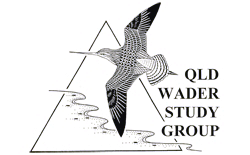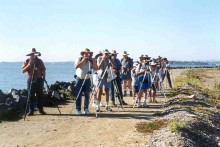What’s Happening at QWSG over the next few months?
QUEENSLAND WADER STUDY GROUP (QWSG)
A Special Interest Group of the Queensland Ornithological Society Inc.
POSITION STATEMENT ON THE RAMSAR CONVENTION AND A PROPOSAL TO BUILD A RESIDENTIAL AND RETAIL DEVELOPMENT OVER INTERTIDAL MUDFLATS AT TOONDAH HARBOUR, MORETON BAY, QUEENSLAND.
Dated: 20 September, 2021
The Queensland Wader Study Group calls on the Australian Federal Government, the
Queensland State Government and the Redland City Council to respect obligations to protect
internationally-recognised wetlands at Toondah Harbour in Moreton Bay under the Ramsar
Convention.
Australia became a signatory to the Ramsar Convention 50 years ago in 1971. The proposal
to develop a residential and retail complex over intertidal mudflats to the north of the existing
Stradbroke Island Ferry terminal will, if it proceeds, extinguish part of the Moreton Bay
Ramsar site. Should it proceed, its lengthy construction period will disturb a wider area of
Moreton Bay marine environment.
QWSG recognises that the existing ferry terminal needs renewal to support the economic and
social advancement of North Stradbroke Island and supports appropriate and environmentally
sound develop of the ferry terminal and its links to the island. QWSG does not support the
current proposed develop that extends well beyond the terminal site to extinguish
approximately 44 hectares of marine coastal habitat.
Australia became a signatory to the Ramsar Convention in 1971 and has remained a
supporter of international obligations under the Convention with more that 70 Australian
wetlands registered by Australia under the Convention. QWSG notes that in recent years two
development applications submitted to the Commonwealth under the EPBC Act (1999) that
would have impacted upon Australian coastal Ramsar sites have been declined by the Federal
Minister for the Environment – the first at Turtle Cove on the Queensland Fraser Coast and
the second adjacent to the Ramsar site at Eighty-mile Beach in Western Australia. QWSG
welcomes the decisions of the Minister for the Environment to protect the coastal habitats for
migratory shorebirds in these international-recognised important areas.
Moreton Bay become a Ramsar site in 1993, one year after the Bay was gazetted a marine
park in Queensland. Surveys of shorebirds conducted by QWSG formed a part of the
information that led to the gazetting of the Moreton Bay Marine Park in 1992 and
subsequently to the declaration of parts of the marine park as a Ramsar site the following
year. Since that time QWSG has worked with all levels of government, the private sector and
community organisations to improve the conservation of Moreton Bay as one of Australia’s
most significant migratory shorebird habitants. QWSG is recognized both nationally and
internationally for its practical on-the-ground work and for its advisory role with
governments, the private sector and non-government sector. QWSG has provided advice and
submissions to the Commonwealth Government on the proposed Toondah Harbour
development. It has also made available to the developer’s consultant appropriate data on
shorebirds in Moreton Bay.
In the interests of public accountability and citizen engagement, QWSG calls on the
Queensland State Government and the Redland City Council to be transparent in their
arrangements with the developer about the Toondah harbour proposal. QWSG notes
that some aspects of the arrangements between the developer and government remain
‘commercial-in -confidence’.- The QWSG calls on the Queensland State Government to withdraw the declaration of
a Priority Development Area for the wetlands to the immediate north of the Toondah
Ferry terminal and reaffirm its commitment to the protection of the Moreton Bay
Ramsar site. - The QWSG calls in the Federal Minister of the Environment to safeguard the Moreton
Bay Ramsar site by upholding the obligations under the Ramsar Convention and
declining the application for the development of a residential and retail development
over the wetlands at Toondah Harbour.
Contact Details:
David Edwards, Chair, QWSG, gouldian6@bigpond.com – 07 3262 2017
Robert Bush, Committee member, cphcrobert@gmail.com – 0404805558
Website: www.waders.org.au
Fieldwork
The monthly count programme happens all year round, have a look at the count page for dates and if your interested in getting involved contact the Count Coordinator for more information. The count dates for our count program are published on the count program page. Please note we are desperately short of counters so if you’re interested and can commit a little time each month to count a site, or act as a backup for a site please get in touch, we really need your help and Linda Cross would love to hear from you. Banding occurs regularly, from October to February, at a range of sites. This is always subject to weather so dates are only arranged at relatively short notice. Please contact Jon Coleman if you are interested in coming along to help out with banding and see below for more information. Please do note that much of our fieldwork involves access to private land and also permits to conduct work in many cases. As a result we do have to consider insurance and also access and permit restrictions when inviting new members along. This means, that although normally we love to involve new people, it can sometimes take a while before we can do so.
Far-Eastern Curlew and Whimbrel tracking
For updates on the migration tracking of these two species please use this link to see regular updates as the birds are tracked on their migration north. **NEW** The latest movements our Godwits and Whimbrel are now available on the above link**. All other tracking data for previous years can be accessed from the links on This Page
My Shorebird Watcher
QWSG’s new shorebird watcher app is now available through the App Store. Why not download the app and give it a go? Please do look at the Privacy policy, available here
** NEW ** Wader Course ** NEW
QWSG are please to announce a wader course in 2020, scheduled at Maaroom, on Monday 17th February. Details and joining instructions are in the flyer available HERE.
Wader ID Days
WADER ID DAYS – MANLY HARBOUR WADER ROOST Sunday 1 December 2019 2.28 m high tide at 12:40. Meeting time 13:00. Saturday 4 January 2020 1.87 m high tide at 15:57. Meeting time 15:45. Meeting Place: At the end of Davenport Dr on the southern boundary of the Royal Queensland Yacht Squadron. Under the conditions of the access agreement for the wader roost, participants must wear enclosed footwear and will be required to sign a form acknowledging responsibility for their own health and safety, including: • wearing protective clothing at all times (eg. hat, sunglasses) and using sunscreen • drinking water to avoid dehydration • using insect repellant if necessary • telling a leader about any health issues that may affect taking part in the field trip • if feeling unwell, or concerned about someone else being unwell, immediately telling a group leader or another participant • immediately telling a group leader or another participant about any injury suffered (including a slip, trip, fall and snake bite) or hazard that may cause injury to someone. Anyone who does not comply with these conditions will not be allowed to enter the site or asked to leave. The gate will be locked after we enter the site and late arrivals will not be able to enter. Participation in this field trip is strictly limited to those who have registered with the leaders. Please do not just turn up on the day without registering. Leaders: Arthur and Sheryl Keates 3843 1874 or 0490951661. Wader ID days Kakadu Beach roost Bribie Island Sunday 12 January 2020 2.66m high tide at 10:47. Meeting time 09.00 onwards. Sunday 9 February 2020 2.69m high tide at 09.45 am. Meeting time 08.45 onwards. We are hoping that the king tide will help produce a variety of birds onto this roost as the large tide may push the waders off other roosts. Take the Bruce Highway north from Brisbane and take the Bribie Island exit. Continue on this road to Bribie Island and follow the signs to Banksia Beach. When you arrive at the T-junction at Banksia Beach turn left and after a short distance turn right into the car park for the roost. A bird hide is positioned at both ends of the roost. Bring morning tea (and lunch for those keen wader enthusiasts), and a chair. It is a good idea to have a hat, sunscreen and insect repellent. Most importantly bring your binoculars or telescopes. Hopefully we can provide the answers to all your questions. Please contact Phil & Linda Cross 5495 2758 if you have any questions. Linda’s mobile: 0490 080 340 Wader ID days Toorbul Saturday 1 February 2020 at Toorbul 1.93m high tide at 14:31. Meeting time 13.00. Saturday 29 February 2020 at Toorbul 2.00m high tide at 13:10. Meeting time 11:30. Take the Bruce Highway north from Brisbane to the Donnybrook/Toorbul exit. Turn off here and head east over the highway overpass. Continue on this road to Toorbul. Turn right at the T-junction then first left and then right, which brings you onto the Esplanade. Follow this road to the end (approximately 2kms); we will be on the left. Bring water, food and a chair. It is a good idea to have a hat, sunscreen and insect repellent. Most importantly bring your binoculars or telescopes. Hopefully we can provide the answers to all your questions. Please contact any of the following people if you have any questions. Phil & Linda Cross 5495 2758. Linda’s mobile: 0490 0800 340
Surveys ** NEW **
QWSG committee have decided to once again undertake surveys of both Mackay and the Great Sandy Strait. All members and interested wader counters are welcome to participate in either or BOTH surveys. The proposed dates are as follows: Mackay survey: 26 – 27 October 2019. Great Sandy Strait survey: date to be selected (early in 2020). Interested participants please contact Peter Driscoll, Peter Rothlisberg or Linda Cross for details. Peter Driscoll – email: pdwaes@gmail.com or phone: 0418 212 627. Peter Rothlisberg – email: Peter.Rothlisberg@csiro.au or phone: 3822 3759 Mobile: 0419 702 674 Linda – email: xenus69@bigpond.com or phone: 54952758 Mobile: 0490 080 340 Accommodation and transport costs during both surveys will be provided by QWSG. In Mackay, air flights and most food costs will also be covered for participants. We need counters to undertake each survey efficiently, but always appreciate more counters if interested. Participants do not need to be experienced and are most welcome. They will be partnered with experienced counters, although final numbers may be limited by funds and resources to transport and accommodate people. For the GSS survey, vehicle fuel costs travelling to and from the survey will also be reimbursed.
Wader Counts
As a group we count every month of the year and are always looking for new counters, particularly so at the moment. Contact the count coordinator if you’re interested in getting involved. Please note you need to be a member of the group for insurance purposes. Take a look at the count program page and contact our count coordinatorr if you would like to be involved
Wader Banding
QWSG have a program of shorebird banding throughout the year and we welcome helpers who want to come along, assist, learn about banding and potentially get involved in banding longer term. Numbers may be limited so anyone wishing to attend must ensure they have spoken to the organiser before trying at attend. If you are interested in helping out please contact Jon Coleman at Jon Coleman for more information. For insurance purposes you will need to be a member of either Birds Queensland or the Queensland Wader Study Group.

